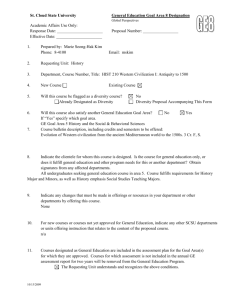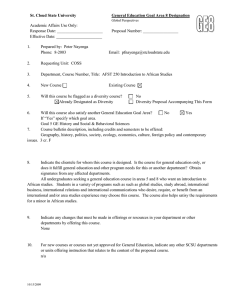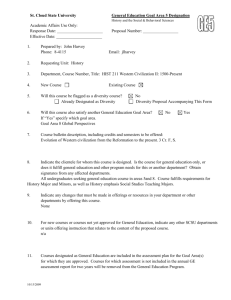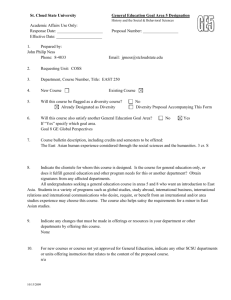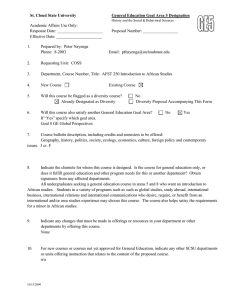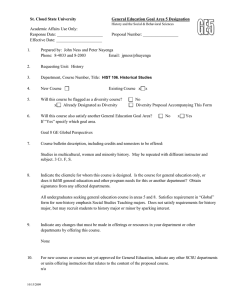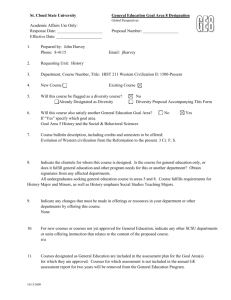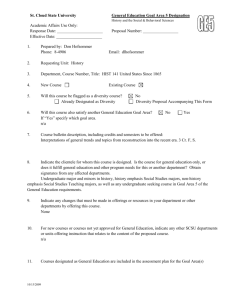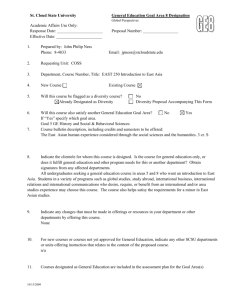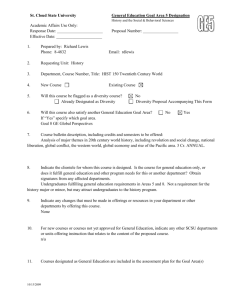GE-10-17. HIST 210 Western Civilization I
advertisement
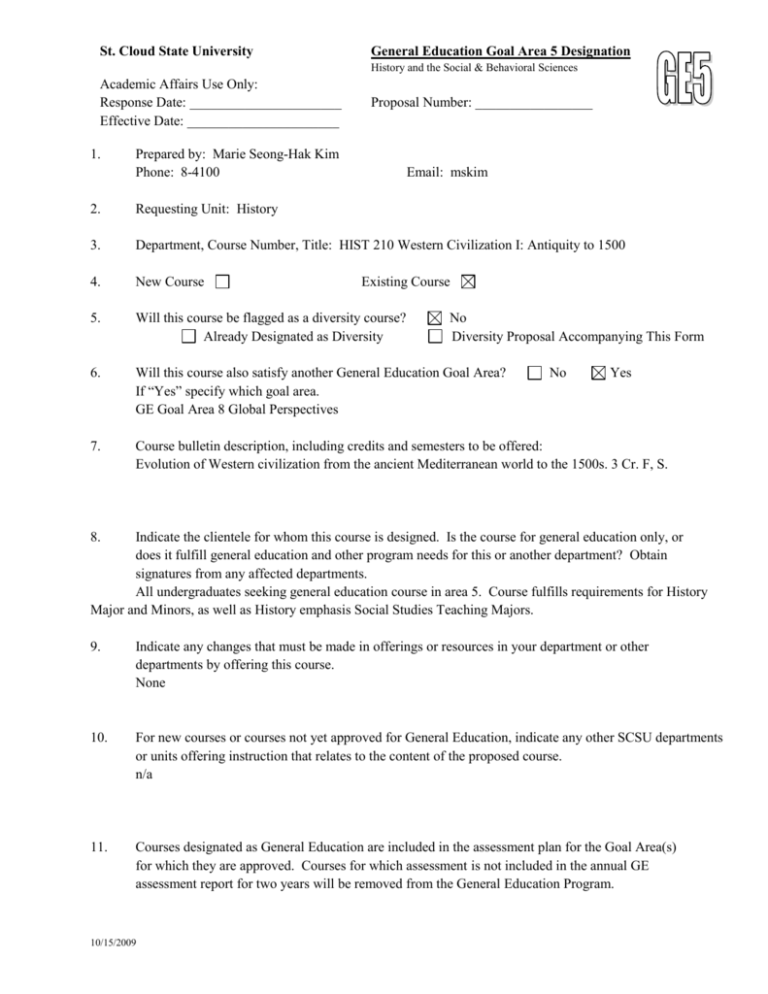
St. Cloud State University General Education Goal Area 5 Designation History and the Social & Behavioral Sciences Academic Affairs Use Only: Response Date: ______________________ Effective Date: ______________________ 1. Proposal Number: _________________ Prepared by: Marie Seong-Hak Kim Phone: 8-4100 Email: mskim 2. Requesting Unit: History 3. Department, Course Number, Title: HIST 210 Western Civilization I: Antiquity to 1500 4. New Course 5. Will this course be flagged as a diversity course? Already Designated as Diversity 6. Will this course also satisfy another General Education Goal Area? If “Yes” specify which goal area. GE Goal Area 8 Global Perspectives 7. Course bulletin description, including credits and semesters to be offered: Evolution of Western civilization from the ancient Mediterranean world to the 1500s. 3 Cr. F, S. Existing Course No Diversity Proposal Accompanying This Form No Yes 8. Indicate the clientele for whom this course is designed. Is the course for general education only, or does it fulfill general education and other program needs for this or another department? Obtain signatures from any affected departments. All undergraduates seeking general education course in area 5. Course fulfills requirements for History Major and Minors, as well as History emphasis Social Studies Teaching Majors. 9. Indicate any changes that must be made in offerings or resources in your department or other departments by offering this course. None 10. For new courses or courses not yet approved for General Education, indicate any other SCSU departments or units offering instruction that relates to the content of the proposed course. n/a 11. Courses designated as General Education are included in the assessment plan for the Goal Area(s) for which they are approved. Courses for which assessment is not included in the annual GE assessment report for two years will be removed from the General Education Program. 10/15/2009 The Requesting Unit understands and recognizes the above conditions. 12. Provide a concise explanation of how the following goal is a “significant focus” of the proposed course. Goal Area 5: History and the Social & Behavioral Sciences Develop understanding of human societies and behaviors, and of the concepts, theories, and methods of history and the social sciences. Through the examination of Western Civilization students will acquire a familiarity with major events and figures as studied via different human societies and behaviors. The student will also develop skills in critical reading of both primary and secondary sources, in research, in the comprehension of textual and lecture material, in class discussion, and in the composition of essays. 13. In order for a course to be designated as fulfilling Goal Area 5, it must address at least 4 of the 5 student learning outcomes (SLOs) below. Check the SLOs below that are focused on in the proposed general education course. 1. Describe or use the methods and data by which historians, social scientists, or behavioral scientists investigate human conditions. 2. Analyze human behavior, cultures, and social institutions and processes from the perspectives of history or the social and behavioral sciences. 3. Develop explanations for and explore solutions to historical or contemporary social problems. 4. Reflect upon themselves in relation to family, communities, society, culture, and/or their histories. 5. Apply and critique alternative explanatory systems or theories about human societies and behaviors. 14. Discuss how each Student Learning Outcome checked above is achieved in this course. (Note: Although descriptions of typical assignments or types of assignments may be part of this discussion, it is not appropriate to submit copies of actual assignments.) 1. Students obtain core knowledge in historical developments of the Western world and its interactions with the outside world. The achievement of knowledge is evaluated through frequent exams, document analyses, writing assignments, oral presentations, and discussions. 2. Students are taught how to analyze historical information critically, with a particular emphasis placed on reading and analyzing primary sources. 3. Students learn how historical forces have shaped analytical categories for investigating political, cultural, and social developments in the contemporary world and learn how to apply their historical knowledge in a contemporary setting. The achievement of these learning objectives is evaluated through their ability in making coherent and reasoned arguments in both writing and oral presentations. 4. Individuals, communities, societies and their histories have never occurred in a vacuum. Students learn the importance of understanding themselves in terms of communities and societies in the Western world and a broader global context. 5. Students are introduced to various revisionist historical explanations and learn how to analyze or critique them. 15. List or attach the Course Outline (adequately described and including percentage of time to be allocated to each topic). Curriculum Committees may request additional information. Topics larger than 20% need 10/15/2009 1. 2. 3. 4. 5. 6. 7. 8. 9. 10. to be broken down further. Indicate in your course outline where the Student Learning Outcomes checked above are being met. The Student Learning Outcomes are met throughout the curriculum described in the course outline below: The first civilizations (Mesopotamia, Egypt and the Ancient Near East) 10% The development of Greek polis and the rise of democracy 10% The Roman republic and empire 10% The rise of Christianity 10% The rise and spread of Islam 10% The medieval states and society 10% The rise of national monarchies 10% The medieval intellectual world and the revival of Roman law 10% The late medieval Europe and the Christian church 10% Italian city states and the Renaissance 10% 10/15/2009
